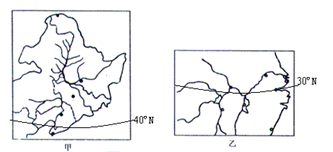问题
综合
读我国甲、乙两个地区图,回答下列问题。(14分)

(1)甲为我国_______________(2分)地区,乙为我国_______________(2分)地区。
(2)甲地的气候特点是____(2分)
(3)乙地的气候类型是_______________(2分)
(4)简述长江三角洲发展农业的优势区位条件(自然条件)(6分)
答案
小题1:东北(2分) 长江中下游 (2分)
小题2:夏季高温多雨,冬季寒冷干燥(2分)
小题3:亚热带季风气候(2分)
小题4:雨热同期 热量充足 降水丰沛 水源充足 地势平坦 土壤肥沃(任答3点,言之有理即可给分)(6分)
题目分析:
小题1:根据图示的经纬度位置和轮廓判断,甲表示我国的东北地区;乙地为我国长江中下游平原。
小题2:甲地的气候类型为温度季风气候,故夏季高温多雨,冬季寒冷少雨。
小题3:我国长江流域位于南方地区,受亚热带季风气候影响。
小题4:影响农业生产的自然条件可从气候、地形、土壤、水源等因素分析。
点评:本题解题的基本步骤:一、利用经纬度定位;二、根据地理位置确定气候类型、三、结合气候类型判断气候特征;四、调用区位分析的一般思维,分析影响农业生产的主要区位因素。注意分析的完整性和全面性。
